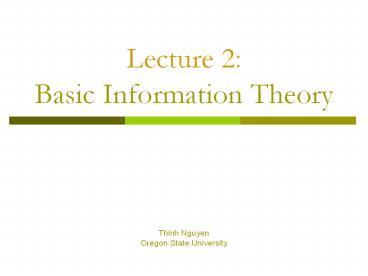Lecture%202:%20Basic%20Information%20Theory - PowerPoint PPT Presentation
Title:
Lecture%202:%20Basic%20Information%20Theory
Description:
Lecture 2: Basic Information Theory Thinh Nguyen Oregon State University What is information? Can we measure information? Consider the two following sentences: There ... – PowerPoint PPT presentation
Number of Views:147
Avg rating:3.0/5.0
Title: Lecture%202:%20Basic%20Information%20Theory
1
Lecture 2Basic Information Theory
Thinh NguyenOregon State University
2
What is information?
- Can we measure information?
- Consider the two following sentences
- There is a traffic jam on I5
- There is a traffic jam on I5 near Exit 234
Sentence 2 seems to have more information than
that of sentence 1. From the semantic viewpoint,
sentence 2 provides more useful information.
3
What is information?
- It is hard to measure the semantic information!
- Consider the following two sentences
- There is a traffic jam on I5 near Exit 160
- There is a traffic jam on I5 near Exit 234
Its not clear whether sentence 1 or 2 would have
more information!
4
What is information?
- Lets attempt at a different definition of
information. - How about counting the number of letters in the
two sentences
- There is a traffic jam on I5 (22 letters)
- There is a traffic jam on I5 near Exit 234
(33 letters)
Definitely something we can measure and compare!
5
What is information?
- First attempt to quantify information by Hartley
(1928). - Every symbol of the message has a choice of
possibilities. - A message of length , therefore can have
distinguishable possibilities. - Information measure is then the logarithm of
Intuitively, this definition makes sense one
symbol (letter) has the information of
then a sentence of length should have
times more information, i.e.
6
How about we measure information as the number of
Yes/No questions one has to ask to get the
correct answer to a simple game below
How many questions?
1 2
3 4
2
1 2 3 4
5 6 8
9 10 11 12
13 14 15 16
How many questions?
7
4
Randomness due to uncerntainty of where the
circle is!
7
Shannons Information Theory
Claude Shannon A Mathematical Theory of
Communication
Bell System Technical Journal, 1948
- Shannons measure of information is the number of
bits to represent the amount of uncertainty
(randomness) in a data source, and is defined as
entropy
Where there are symbols 1, 2, ,
each with probability of occurrence of
8
Shannons Entropy
- Consider the following string consisting of
symbols a and b - abaabaababbbaabbabab .
- On average, there are equal number of a and b.
- The string can be considered as an output of a
below source with equal probability of outputting
symbol a or b
a
0.5
We want to characterize the average information
generated by the source!
0.5
b
source
9
Intuition on Shannons Entropy
Why
Suppose you have a long random string of two
binary symbols 0 and 1, and the probability of
symbols 1 and 0 are and Ex
00100100101101001100001000100110001 . If any
string is long enough say , it is likely to
contain 0s and 1s. The
probability of this string pattern occurs is
equal to
Hence, of possible patterns is
bits to represent all possible patterns is
The average of bits to represent the symbol is
therefore
10
More Intuition on Entropy
- Assume a binary memoryless source, e.g., a flip
of a coin. How much information do we receive
when we are told that the outcome is heads? - If its a fair coin, i.e., P(heads) P (tails)
0.5, we say that the amount of information is 1
bit. - If we already know that it will be (or was)
heads, i.e., P(heads) 1, the amount of
information is zero! - If the coin is not fair, e.g., P(heads) 0.9,
the amount of information is more than zero but
less than one bit! - Intuitively, the amount of information received
is the same if P(heads) 0.9 or P (heads) 0.1.
11
Self Information
- So, lets look at it the way Shannon did.
- Assume a memoryless source with
- alphabet A (a1, , an)
- symbol probabilities (p1, , pn).
- How much information do we get when finding out
that the next symbol is ai? - According to Shannon the self information of ai is
12
Why?
Assume two independent events A and B,
withprobabilities P(A) pA and P(B) pB.
For both the events to happen, the probability
ispA pB. However, the amount of
informationshould be added, not multiplied.
Logarithms satisfy this!
No, we want the information to increase
withdecreasing probabilities, so lets use the
negativelogarithm.
13
Self Information
Example 1
Which logarithm? Pick the one you like! If you
pick the natural log,youll measure in nats, if
you pick the 10-log, youll get Hartleys,if you
pick the 2-log (like everyone else), youll get
bits.
14
Self Information
H(X) is called the first order entropy of the
source.
This can be regarded as the degree of
uncertaintyabout the following symbol.
15
Entropy
Example Binary Memoryless Source
16
Example
Three symbols a, b, c with corresponding
probabilities
P 0.5, 0.25, 0.25
What is H(P)?
Three weather conditions in Corvallis Rain,
sunny, cloudy with corresponding probabilities
Q 0.48, 0.32, 0.20
What is H(Q)?
17
Entropy Three properties
- It can be shown that 0 H log N.
- Maximum entropy (H log N) is reached when all
symbols are equiprobable, i.e.,pi 1/N. - The difference log N H is called the redundancy
of the source.































